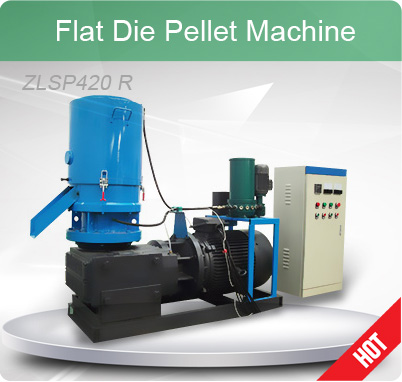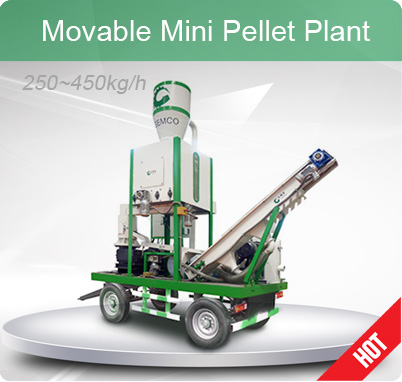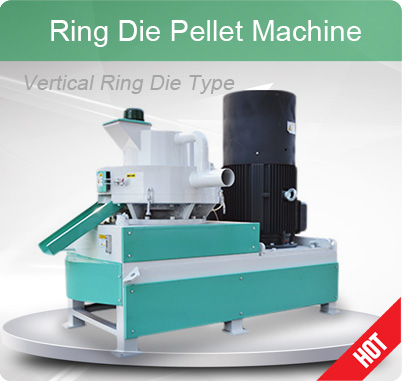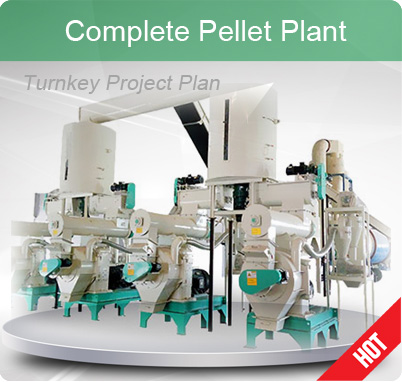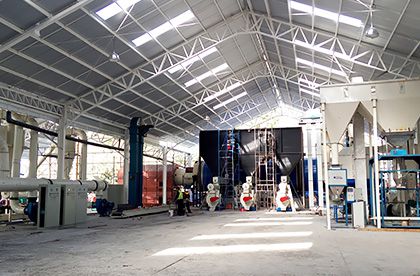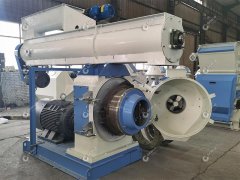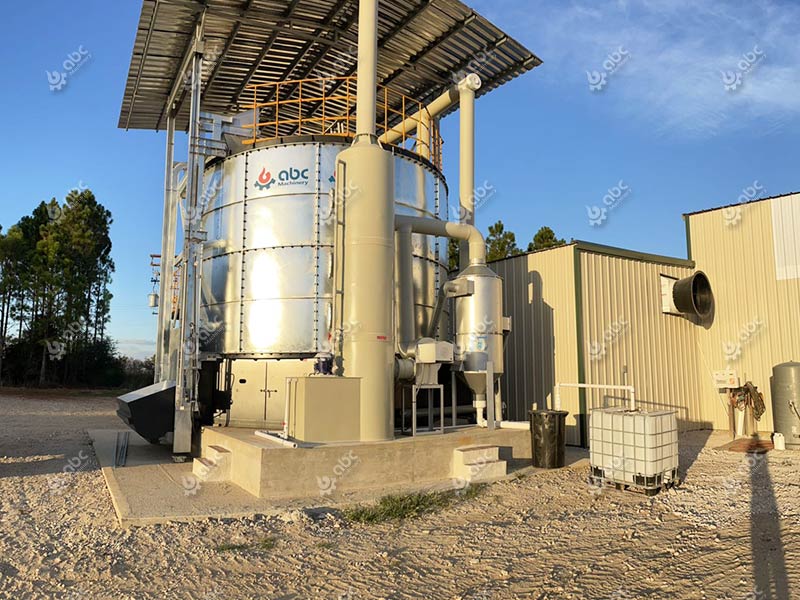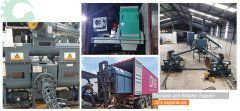Wood Pellet Plant Process: Mastery of Pelletizing Technology
Wood pellet production is an important biomass energy production process, the success of which is directly related to energy sustainability and environmental protection. In this paper, we will explore the key process technologies in wood pellet production, including pre-treatment of raw materials, pellet size control, optimization of energy consumption, pellet size and shape control, temperature and pressure control, use of additives, maintenance and cleaning of equipment, and process monitoring and adjustment. In addition, we will look at drying and cooling technologies in wood pellet making lines, as well as pellet packaging technologies, to present you with the key aspects of the wood pellet production process and help you better understand this dynamic industry. Whether you are involved in wood pellet making or interested in, this article will provide you with important insights into biomass pelletization process. (Learn more about Start A Wood Pellet>>)
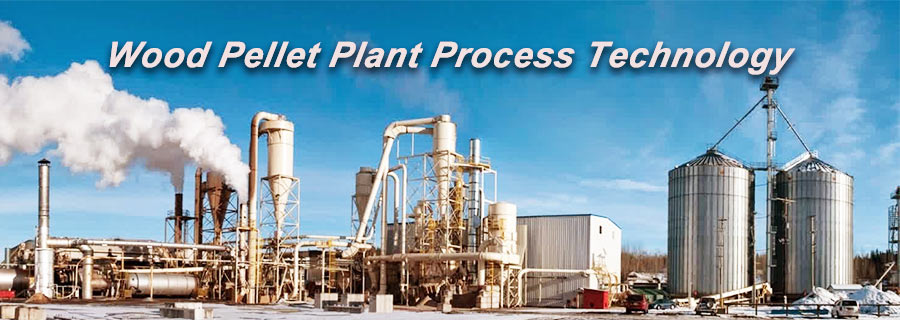
Wood Pellet Process Technology in Biomass Pellet Plant
The commercial plant wood pellet production process typically includes the following major steps: feedstock preparation, crushing, drying, pelletizing and packaging. First, the feedstock is usually wood waste, such as wood shavings, sawdust and chips, which must be cleaned and sorted to remove impurities. Next, the feedstock is crushed into smaller particles and then passed through a drying process to reduce moisture, usually using a rotary dryer or other equipment. Subsequently, wood pelletizing is done by compressing the wood material into pellets, which usually requires a wood pellet mill. Finally, the produced wood pellets are packaged into bags or other containers for sale or storage.
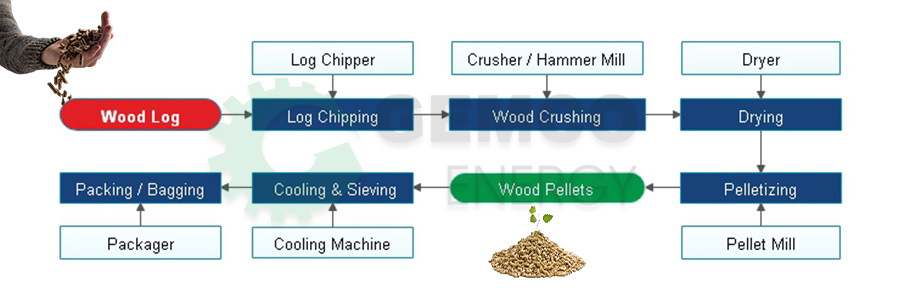
Wood Pellet Pruduction Process Flow Chart
Raw Material Size Reduction Techniques in Wood Pellet Plant Processes
Raw material size reduction is one of the key steps of pelletizing technology to increase productivity, reduce energy consumption and improve pellet quality. Raw material reduction is achieved by Wood Crusher, Wood Chipper, Hammer Mill in wood pellet production plants.
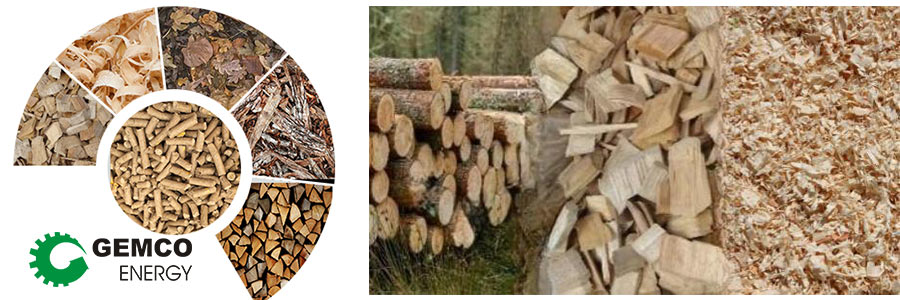
Process Raw Materials to Wood Pellet
- Raw Material Pre-Treatment: Removing excess bark, impurities, metals, etc. helps to protect the crusher and increase the efficiency of the wood pellet process.
- Optimize Energy Consumption: When crushing raw materials, reasonable operation and maintenance of wood pellet manufacturers can reduce energy consumption and wood pellet production cost. This requires the factory to choose different processing machines according to the different characteristics of the raw materials. (Link to Softwood and Hardwood Pellets>>)
| Granule Diameter | 6mm | 8mm | 10mm |
|---|---|---|---|
| Raw Material Size | 4-5mm | 6-7mm | 8-9mm |
In wood pellet plant process, although wood chipper, hammer, and crusher machines are all used to process raw materials, different machines have different capabilities and functions to process raw materials. Wood chipper is typically used for the initial treatment of wood by cutting it into smaller pieces or flake shapes with dimensions less than 3 mm thick and 10-30 mm long. Hammer machine is mainly used for coarse crushing of wood to further reduce the size of the pieces or chippings to 2-5mm. Wood crusher, on the other hand, is typically used to pulverize wood into the desired particle size, which is necessary for the preparation of wood pellets. Each type of machine plays an important role in wood pellet production, and understanding the differences in their functions and performance can help you better select the appropriate machine for your production needs.
If you require more information or have any questions, please click the links below for free consulting services.
Wood Pellet Drying Technology in Pellet Plant Process
The raw material drying step is an important step in the molding of wood pellets and is usually done by drying equipment. The key objective of this stage is to reduce the moisture in the wood pellets to an appropriate moisture content (10-20%) to ensure that the pellets can maintain stability and quality during subsequent molding and compression. The Rotary Dryer is most commonly used in biomass pellet plants.

Dry Machine of Biomass Pellet Process Production Line
| Operating Principle | Complexity | Key Features | |
|---|---|---|---|
| Hot Air Drying | Evaporates moisture from materials using hot air | Moderate | Efficient, versatile, widespread application |
| Rotary Drying | Utilizes centrifugal force to atomize wet materials into a high-speed airflow | Low | Fast drying, simplicity, low energy consumption |
| Fluidized Bed Drying | Suspends solid particles in high-velocity air stream for drying | High | Broad applicability, uniform products, high product quality |
Wood Pelletizing Process Techniques in Pellet Production Process
In pelletizing practice, the wood pellet plant should consider the raw material characteristics, pelletizing parameters, and the state of the wood pellet mill machine, and then optimize the wood pellet plant technology to obtain reliable pellet products.
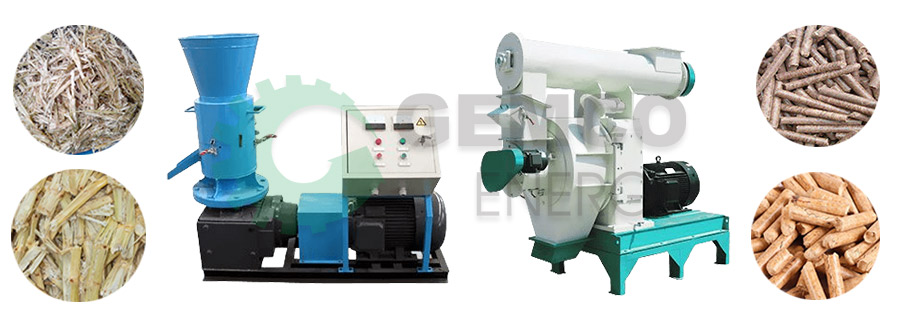
Flat Die Wood Pellet Processing Machine & Ring Die Wood Pellet Processing Machine
- Pellet Size and Shape Control:
During the wood pellet process, the size and shape of the pellets can be controlled by adjusting the molds, rollers, and other components of the wood pellet press machine. The most common diameters of pellets was 6 mm, followed by 8 mm and 10 mm. Regarding length, the standard prEN 14961-2 sets the length of pelletized fuel to be typically no longer than 40 mm.
- Temperature and Pressure Control:
Proper temperature and pressure can improve the density and structure of pellets. Depending on the characteristics of the feedstock and the design of the pelletizer equipment, temperatures can range from 50°C - 100°C. For pressure, the compression ratio (the ratio of the aperture to the channel length) controls the amount of pressure in the channel. Typically, the compression ratio for woody biomass pelletizer is 1:3 or 1:5. Feedstocks that do not have a great deal of bonding strength of their own need to pass through longer compression passages, and the temperature inside the passages rises as the length of the passages increases. Therefore, the hardness of the pelletized fuel also increases with the length.
- Use of Additives:
Some bio-binding agents are added during the wood pellet making process to improve the mechanical properties of the wood granulator and the combustion characteristics of the pellets. According to the experimental results, bio-additives are more important for pellet fuels with a diameter of 6 mm. However, it is less important for burning pellets with a diameter of 8mm and 10mm, because larger combustion units are easier to handle pellets than smaller stoves. It should be noted, however, that additives should be used with care to avoid adverse effects.
- Maintenance and Cleaning:
Attention should be paid to regular maintenance and cleaning of industrial wood pellet maker machine to alleviate, problems such as clogging and wear and tear that often occur in wood pellet making machine.
The pellet tech of the wood pellet plant process is undertaken by biomass wood pellet making equipment. At present, biomass pellet mills are mainly divided into Flat Die Pellet Mill and Ring Die Pellet Mill. Flat die pellet machine price is low and suitable for small scale wood pellet production. On the contrary, the ring die pellet machine price is high and suitable for large scale wood pellet production. You can choose the right biomass pellet mill according to your budget and output requirements. (Link to Buy Wood Pellet Oline>>)
If you want to know how to choose the right biomass pellet mill for you, please feel free to contact us!
Cooling and Packing Process in Wood Pellet Plant Technology
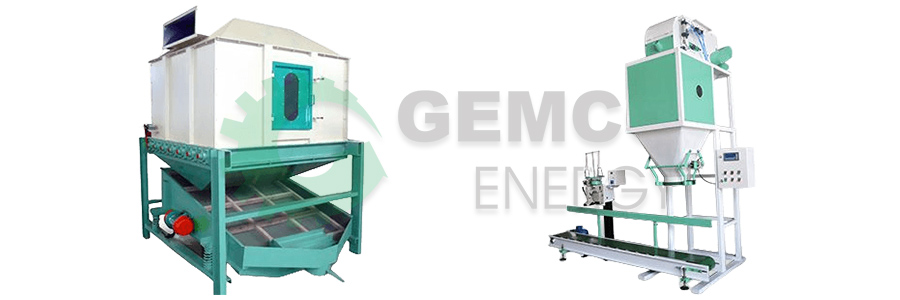
Pellet Cooler Equipment & Pellet packing Machine
Cooling Technology of Pellet Cooler Machine in Wood Pelletizing Plant
Cooling technologies is also crucial steps in a biomass wood pellet production line, and it is realized through the use of Pellet Cooler Equipments. Here is more information about different cooling techniques.
| Working Principle | Applications | Features | |
|---|---|---|---|
| Cyclone cooling | Separates hot wood pellets from the cooling air by means of a high velocity air stream, which removes the heat. | Large-scale production; a wide range of wood pellets | Highly efficient cooling, relatively simple to operate, low maintenance costs |
| Vibration cooling | Accelerates heat transfer by continuous vibration, resulting in rapid cooling of the pellets. | Small scale production and laboratory applications | Requires low maintenance and is relatively simple to operate |
| Rotary Cooling | Wood pellets are loaded into a rotating cylinder and cooled by an external cooling air stream. | Suitable for large-scale production of a wide range of pellets for high throughput requirements | High throughput and efficiency, uniform pellet cooling |
Pellet Packaging Techniques in Pellet Manufacturing Process
Pellet packaging machine is an indispensable machine for commercial wood pellet plants. The pellet packaging technology of wood pellet line is the key link to ensure product quality and facilitate storage, transportation, and sales. Therefore, the packing process of a wood pellet factory should have the following functions.
- Adapt to a Variety of Packaging Materials: To meet the requirements of environmental protection, and at the same time can effectively protect the pellets from moisture or pollution. Wood pellet processing plants usually choose plastic bags or paper bags.
- Adjustable Packaging Specifications: According to the pellet market demand, determine the appropriate packaging specifications, such as the size of the bag and the amount of pellets packed.
- Sealing and Labeling: Use sealing equipment to ensure the sealing of the bags to avoid leakage of pellets. At the same time, add labels or markings on the packages, including product information, production date and quality certification, etc., to facilitate tracking and sales.
Although there is a wide range of drying and cooling technologies to choose from, pellet plants usually prioritize low-cost and high-efficiency equipment. Therefore, I recommend that you follow the advice of the pellet machine manufacturer when purchasing your equipment. You can also contact us for a free consultation if required.
Contact us to get a free Wood Pellet Plant Process PDF!
GEMCO: Your Best Companion on the Road to Success
A wood pellet production line is a complex and efficient process system where each step, from raw material collection to packaging of the final product, has its own unique importance and challenges. To ensure success, a deep understanding of this field is essential. Efficient production and quality assurance can only be achieved with a deep understanding of the technology and requirements of each biomass pellets manufacturing process. (Link to some wood pellet Project>>)
But more importantly, choosing a professional and experienced partner is a shortcut to success. We are committed to providing you with the most professional wood pellet manufacturing line solutions, whether it is wood pellet plant construction or pellet plant technology upgrading. Over the past 30 years, we have helped wood pellet mill customers in the United Kingdom, Australia, Malaysia, Chile, Serbia, Thailand, Vietnam, South Korea, and many other countries around the world to achieve success. Trust us, GEMCO will be your most reliable partner. Utilize our expertise and experience to help you achieve excellence in wood pellet production. If you need anything, contact us for FREE!


